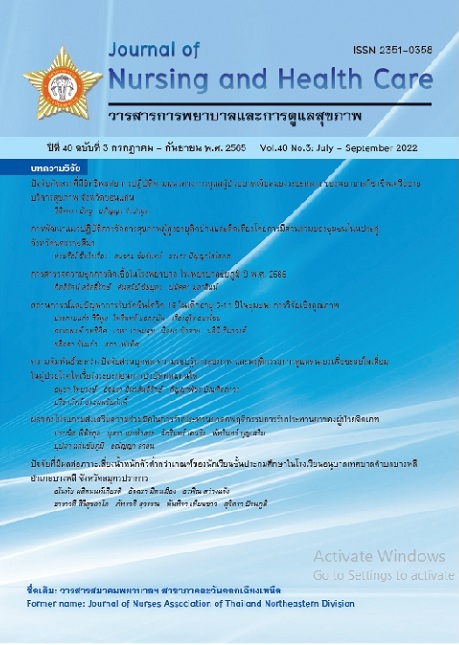การสำรวจความชุกการติดเชื้อในโรงพยาบาล โรงพยาบาลชัยภูมิ พ.ศ. 2565
คำสำคัญ:
การสำรวจความชุก, การติดเชื้อในโรงพยาบาล, ประสิทธิภาพการเฝ้าระวังบทคัดย่อ
การสำรวจความชุกการติดเชื้อเป็นวิธีการเฝ้าระวังที่ได้รับการพิสูจน์และเหมาะสมสำหรับการป้องกันและควบคุมการติดเชื้อในโรงพยาบาล การศึกษาครั้งนี้มีวัตถุประสงค์เพื่อสำรวจความชุกการติดเชื้อ และประเมินประสิทธิภาพการเฝ้าระวัง เครื่องมือที่ใช้ คือ แบบสำรวจความชุก โรงพยาบาลชัยภูมิ ทำการสำรวจผู้ป่วยที่นอนโรงพยาบาลใน 32 หอผู้ป่วย วิเคราะห์ข้อมูลโดยใช้สถิติเชิงพรรณนา
ผลการสำรวจความชุกในผู้ป่วย 559 ราย พบการติดเชื้อ 16 ราย คิดเป็นอัตราชุกการติดเชื้อร้อยละ 2.9 กลุ่มผู้ป่วยที่พบการติดเชื้อมากที่สุดคือ ผู้ป่วยวิกฤต ร้อยละ 7.4 รองลงมาคือ ผู้ป่วยอายุรกรรม และผู้ป่วยจิตเวช ร้อยละ 4.3 เท่ากัน ตำแหน่งที่พบการติดเชื้อมากที่สุดคือ การติดเชื้อทางเดินปัสสาวะจากการใส่สายสวนปัสสาวะ ร้อยละ 43.6 รองลงมาคือ การติดเชื้อปอดอักเสบจากการใส่เครื่องช่วยหายใจ ร้อยละ 25 การติดเชื้อปอดอักเสบและการติดเชื้อในกระแสโลหิต ร้อยละ 12.5 เท่ากัน เชื้อก่อโรคที่เป็นสาเหตุการติดเชื้อมากที่สุดคือ เชื้อ Acinetobacter baumannii (MDR) ร้อยละ 30 รองลงมาคือ เชื้อ Klebsiella pneumoniae (CRE-MDR) และเชื้อ Pseudomonas aeruginosa ร้อยละ 25 และ 20 ตามลำดับ ยาต้านจุลชีพที่ใช้ในการรักษาการติดเชื้อมากที่สุดคือ ยา Meropenem ร้อยละ 28.5 รองลงมาคือ ยากลุ่ม Cephalosporins ร้อยละ 19 และยา Sulperazone ร้อยละ 14.3 ประสิทธิภาพการเฝ้าระวังร้อยละ 68.7 ผลการสำรวจความชุกสะท้อนให้เห็นปัญหาการติดเชื้อที่สำคัญ คือ การติดเชื้อจากการใส่อุปกรณ์การแพทย์ จึงควรส่งเสริมการปฏิบัติในการป้องกันการติดเชื้อจากการใส่อุปกรณ์การแพทย์มากยิ่งขึ้น และประสิทธิภาพการเฝ้าระวังยังคงต่ำ จึงควรพัฒนาศักยภาพพยาบาลควบคุมการติดเชื้อประจำหอผู้ป่วยในการเฝ้าระวังการติดเชื้อให้มากยิ่งขึ้น
Downloads
เอกสารอ้างอิง
Bamrasnaradura Infections Diseases Institute. Guideline for the prevention and control of infection in the hospitals. Bangkok: Aksorn Graphic and Design; 2020. (in Thai).
Saleem Z, Godman B, Hassali MA, Hashmi FK, Azhar F, Rehman IU. Point prevalence surveys of health-care-associated infections: a systematic review. Pathog Glob Health 2019; 113(4): 191-205.
Moolasart V, Manosuthi W, Thienthong V, Vachiraphan A, Judaeng T, Rongrungrueng S, et al. Prevalence and risk factors of healthcare-associated infections in Thailand 2018: A Point prevalence survey. J Med Assoc Thai 2019; 102(12): 1309-16. (in Thai).
Nursing Division. Nursing standards in hospitals (2nd update). Nonthaburi: The war veterans organization’s printing house; 2007. (in Thai).
Attapornkusol P, Rattnaphun N, Wongsasom W, Thongthip C, Muangbamrung N, Intakool P, et al. The epidemiology prevalence rate and surveillance performance of hospital-acquired infections in medical department at Nopparat Rajathanee Hospital. Journal of the Department of Medical Services 2021; 46(1): 80-8. (in Thai).
Bamrasnaradura Infections Diseases Institute. Hospital infection diagnosis book, Bangkok: Aksorn Graphic and Design; 2018. (in Thai).
Phodang J. Preliminary statistics and data analysis for epidemiological disease measurements and patterns. Department of epidemiology faculty of public health, Mahidol University. Documents for training CDCU-6/2562. (in Thai).
Manosuthi W, Thientong V, Moolasart V, Rongrungrueng Y, Sangsajja C, Danchaivijitr S. Healthcare-associated infections at selected hospitals in Thailand. Southeast Asian. J Trop Med Public Health 2017; 48(1): 204-12.
Rodriguez-Acelas AL, Abreu Almeida M, Engelman B, Canon-Montanez W. Risk factors for health care–associated infection in hospitalized adults: systematic review and meta-analysis. Am J Infect Control 2017; 45(12): 149-56.
Septimus EJ, Moody J. Prevention of device-related healthcare-associated infections. F1000Re-search 2016; 5.
Zingg W, Metsini A, Gardiol C, Balmelli C, Behnke M, Troillet N, et al. Antimicrobial use in acute care hospitals: national point prevalence survey on healthcare-associated infections and antimicrobial use, Switzerland 2017. Euro Surveill 2019; 24(33): 1900015.
Teerawattanapong N, Panich P, Kulpokin D, Ranong SN, Kongpakwattana K, Saksinanon A, et al. A systematic review of the burden of multidrug-resistant healthcare-associated infections among intensive care unit patients in Southeast Asia: the rise of multidrug-resistant Acinetobacter baumannii. Infect Control Hosp Epidemiol 2018; 39(5): 525-33. (in Thai).
Vichitranuwat C. Antibiotic utilization and risk factors of MDR Acinetobacter baumannii infection at Surin Hospital. Medical journal of Srisaket Surin Buriram Hospitals 2020; 24(2): 13-24. (in Thai).
Seesuankaew U, Pattharachayakul S, Lerkiatbundit S. Explanation of physicians’ decision to prescribe meropenem: Case study of a hospital in southern Thailand. Thai J Pharm Prac 2021; 13(3): 590-602. (in Thai).
ดาวน์โหลด
เผยแพร่แล้ว
รูปแบบการอ้างอิง
ฉบับ
ประเภทบทความ
สัญญาอนุญาต
ลิขสิทธิ์ (c) 2022 วารสารการพยาบาลและการดูแลสุขภาพ

อนุญาตภายใต้เงื่อนไข Creative Commons Attribution-NonCommercial-NoDerivatives 4.0 International License.



